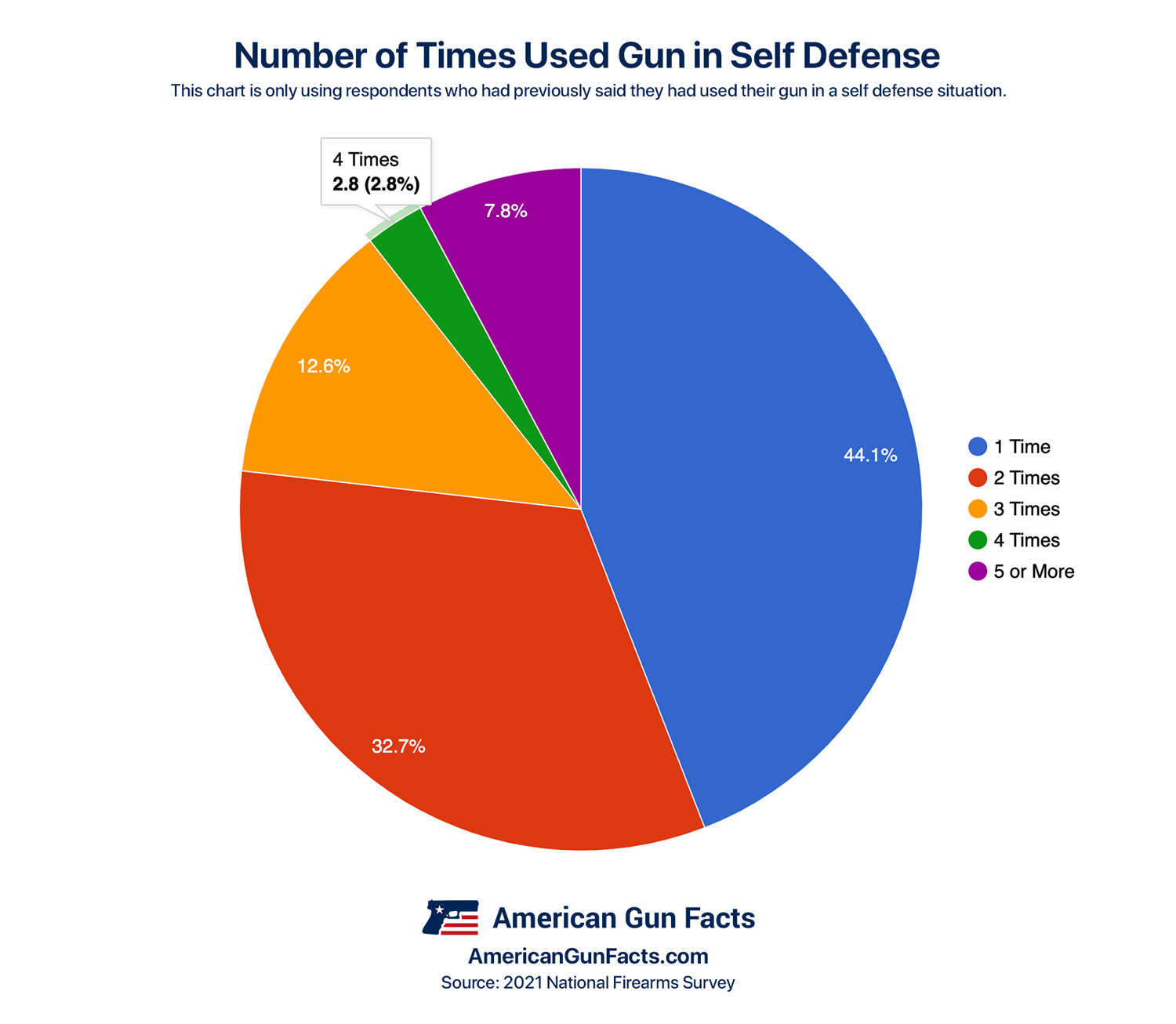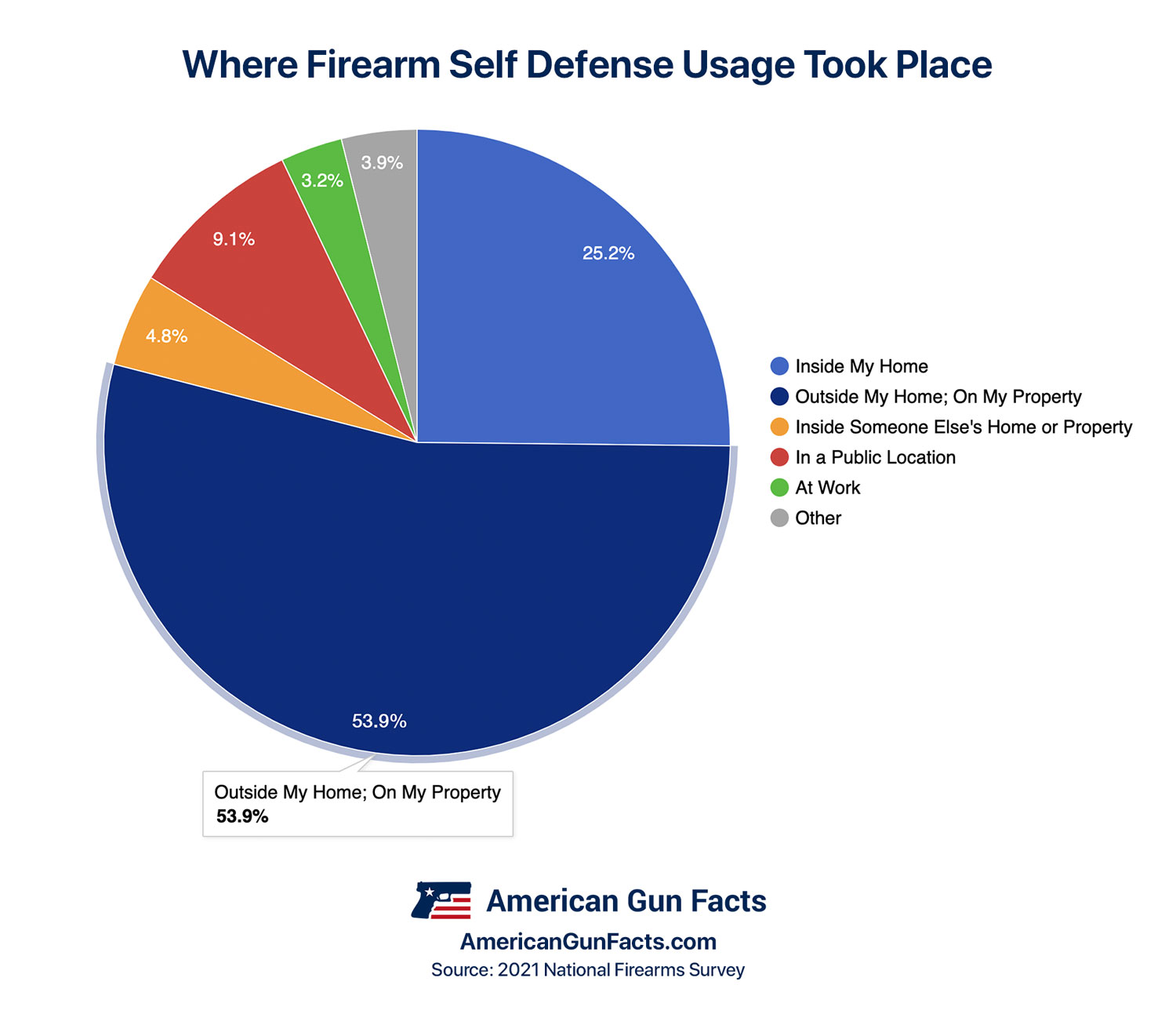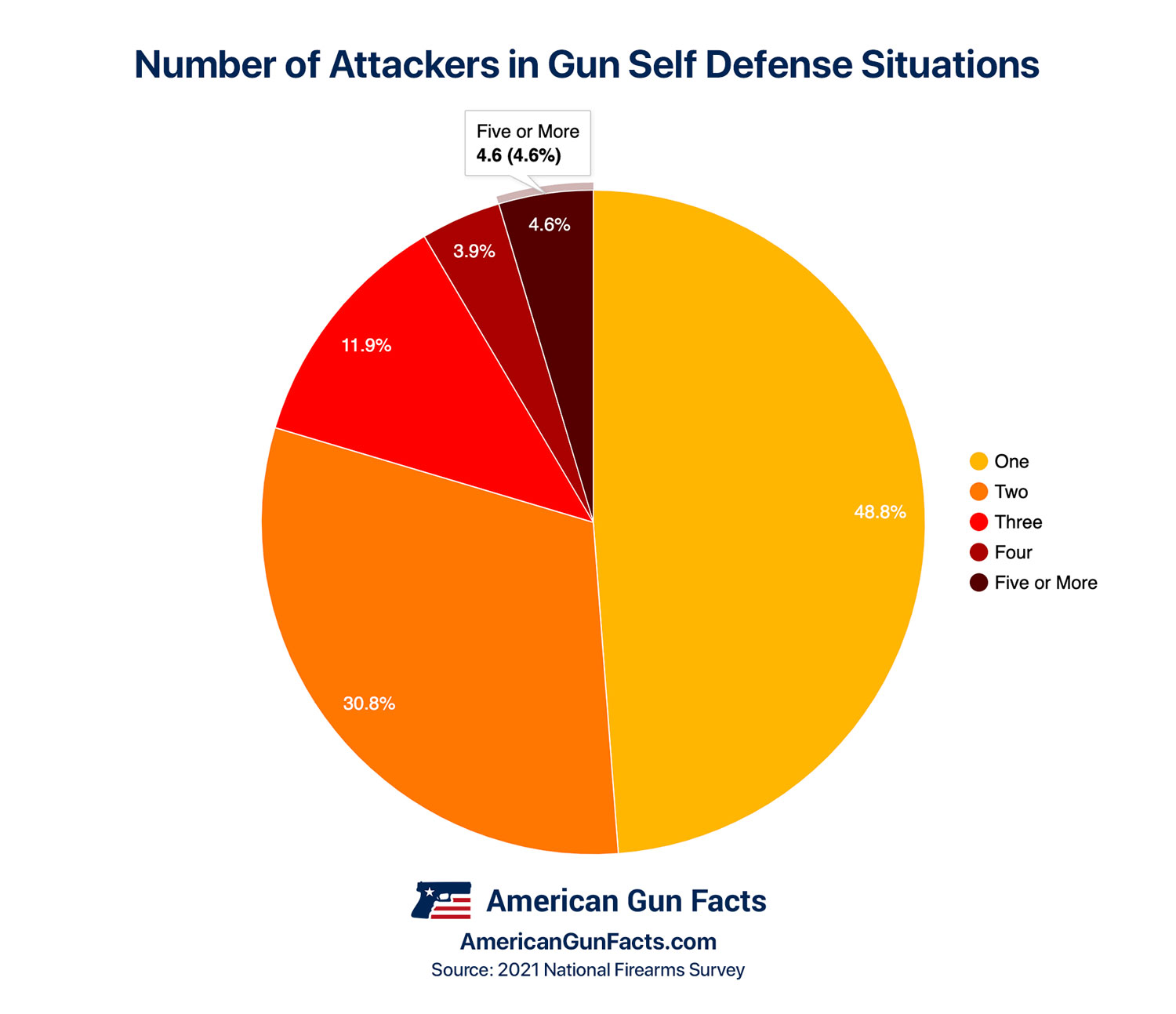Guns used in self defense stats often try to measure the duck that didn’t quack. In other words, there may not be a police report or any other record when no crime was committed or reported. Most of the time a gun is used to prevent a crime, there is no record.
As a result, data on defensive use of force and averted crimes due to the presence of a defensive gun are controversial, contentious, and range widely. Defensive gun use (DGU) statistics generally rely on self-reporting, interviews, police, and media reports which are then extrapolated to the national population using a variety of statistical methods which produce contradictory and often wildly inconsistent estimates.1
How Many Times Are Guns Used in Self Defense Each Year?
The best estimate is that guns are used to deter or thwart crime between 500,000 and 2.8 million times per year, but the more likely answer is probably somewhere in the middle. A 2021 survey2 estimated that guns are used 1.67 million times per year in self defense in the United States.
Estimates range widely with some studies putting this number as low as 65,000 (in 1992). We explain this discrepancy in more detail in the study methodology section.
Defensive Gun Use Statistics
As part of the 2021 National Firearms Survey,2 participants were also asked a number of other questions surrounding defensive gun use. These stats help give more insight into how and why guns are used in self defense each year.
Frequency
31.1% of all gun owners who took the survey said that they had used their firearm in self defense at least once “even if it was not fired or displayed” (not including law enforcement, security, or military service).
In addition, the majority of those answering in the affirmative had used their gun more than once in self defense. Extrapolating this 31.1% data out to all gun owners in America would mean that roughly 25.3 million adults have used a firearm to stop a crime or protect themselves at least once in their life.

| Times Used Gun in Self Defense | Percentage of Respondents |
| 1 Time | 44.1% |
| 2 Times | 32.7% |
| 3 Times | 12.6% |
| 4 Times | 2.8% |
| 5 or More Times | 7.8% |
How Guns Were Used – Were Shots Fired?
No shots were fired in 81.9% of those defensive use cases. 50.9% of the time, displaying the firearm was sufficient to scare off the attacker; 31% of the time, simply telling someone they were armed prevented the attack from taking place. Only 18.1% of the time was firing the gun required to defend their life.

| Method | Usage Percentage |
| Showed the Gun (not Fired) | 50.9% |
| Neither (ex: Told Verbally) | 31% |
| Fired the Gun | 18.1% |
Firearms Used
The most common type of firearm used (by almost two-thirds) was handguns, likely due to their compact nature which makes them easy to concealed carry. Handguns are also easier to maneuver in tight quarter situations such as a home or vehicle.

| Type of Firearm | Usage Percentage |
| Handgun | 65.9% |
| Shotgun | 21% |
| Rifle | 13.1% |
Location
79.1% of these self-defense gun uses reportedly occurred inside the owner’s home or on their property, while 9.1% happened in a public place.

| Place Firearm Used | Usage Percentage |
| Outside My Home but On My Property | 53.9% |
| Inside My Home | 25.2% |
| In Public | 9.1% |
| Someone Else’s Home or Property | 4.8% |
| Other | 3.9% |
| At Work | 3.2% |
Number of Attackers
One value of firearms in self defense are their ability to act as force multipliers. Multiple attackers can easily overwhelm an unarmed victim, but a firearm helps even the odds. The survey found that in the majority of cases of defensive gun use, the gun owner reported facing multiple assailants: 51.2% of incidents included 2 or more attackers.

| Number of Attackers | Percent of Self Defense Situations |
| 1 Assailant | 48.8% |
| 2 Assailants | 30.8% |
| 3 Assailants | 11.9% |
| 4 Assailants | 3.9% |
| 5 or more Assailants | 4.6% |
Gun Carrying & Concealed Carry
A majority of gun owners surveyed (56.2%) claimed to have open or concealed carry a handgun for self defense in some circumstances. This translates to roughly 45.8 million Americans carrying firearms at some point. However, 43.8% of gun owners claimed to never carry their weapon with them and only 9.1% of gun owners claimed to “always or almost always” carry a firearm.

| How Often Carry A Gun in Public | Percent of Respondents |
| Never | 43.8% |
| Only in Dangerous Situations | 21.2% |
| Sometimes | 19% |
| Always (or almost always) | 9.1% |
| Often | 6.9% |
The laws governing concealed and open carrying of firearms varies widely by states. Some have passed “constitutional carry” which requires no permit to open or concealed carry a pistol (except in places prohibited such as schools, bars, etc.), while other states have very strict gun control laws. As such, 34.9% of gun owners claimed to have wanted to carry a handgun for self defense in some circumstances but were prevented by local laws.
Study Methodology & Criticism
It is good to note, that internet surveys are opt-in (self-selecting) and can suffer from the composition fallacy (assuming the whole based on a smaller, unrepresentative sample). That doesn’t mean that it’s wrong – it only means it can’t be taken as the final word on self-defense gun use and we should see if it holds up with other similar studies.
Often cited by pro-gun advocates is the work of Gary Kleck, a Florida State criminologist who, in 1992, determined based on his research that defensive gun use occurred roughly 500,000 – 3 million times each year in the United States.
That same year, the US Justice Department’s Bureau of Justice Statistics under President George H. W. Bush estimated in their annual National Crime Victimization Survey that defensive gun uses occur about 65,000 times per year.3
While the Kleck study relies on extrapolations based on self-reporting in surveys, the NCVS data relies on interviews of victims who reported violent crimes to the police. Both have potential biases and blind spots. While many claim this difference in methodology explains the massive gap in reporting, the National Research Council begs to differ. They claim that Kleck’s methods overestimate the number of defensive use incidents because of respondents lying and misconstruing incidents to make themselves the hero, resulting in false positives. However, the criticism leveled against the methodology of the smaller estimates of the NCVS is also valid. By limiting the pool of interviewees to only those who reported a crime and by limiting the scope of scenarios under which defensive gun uses are counted, these much lower estimates are not accurate as most self defense situations never involve a shot being fired nor a report being filed. Therefore, self reported surveys are often the only method for accounting for those incidents.
Over 20 other similar surveys have been undertaken over the years and also support high numbers of DGUs – even surveys from the CDC itself. In 1996, 1997, and 1998, the Center for Disease Control conducted surveys to gather information on defensive gun uses by American citizens. The results were never published. In 2020, the criminologist Gary Kleck analyzed the raw data from these studies and found that the CDC data resulted in an average of 1,109,825 defensive gun uses each year surveyed.4
More recently, the 2021 National Firearms Survey, conducted by the private polling firm Centiment on behalf of William English of the McDonough School of Business at Georgetown University found that the answer may be even higher.
Their findings, based on extrapolations of an internet poll of gun owners, was that self-defense gun use occurs about 1.67 million times per year in the United States.2 The authors note that this number could be conservative and the real estimate might be closer to 2.8 million defensive gun incidents per year. This range is due to a few assumptions in their methodology (such as gun ownership rate and years people have owned a gun) which might be artificially reducing the incidents in the 1.67 million estimate.
This survey was the largest of its kind to date. They interviewed 54,000 Americans of which 16,000 owned firearms – nearly 10 times larger sample size than the second largest study on defensive gun use so far.
Gun Deaths vs. Lives Saved by Guns
From a public health standpoint, the question is whether the benefits of guns saving lives outweighs the cost of guns in the form of homicide, assault, and injuries?
The CDC reports that 39,707 people died from firearms in 2019.5 Of these deaths, the vast majority (23,941 of them) were from suicides which would have likely taken place with or without firearms. Taking a step back to also include violent crimes in the mix, the National Crime Victimization Survey estimated there were around 480,000 criminal uses of guns in 2019.3
This is where the estimates of defensive gun use start to matter. If the real number is low, most people might conclude that the benefit of widespread private gun ownership is doing more harm than good.
But, if the more recent and likely estimates of 1.67 million (or more) defensive gun uses each year are accurate, then guns are used many more times to save lives than harm them.
While these DGU surveys strengthen the argument of gun rights advocates, in the end our rights do not (and should not) depend on a cost/benefit analysis.
Conclusion
The Second Amendment to the US Constitution specifically permits, in fact defines as a natural right inherent to all people, the freedom to keep and bear arms. As subsequent Supreme Courts have defined the Second Amendment, they have concluded that the right is limited by behaviors such as committing a violent crime, limited by mental health status, and limited geographically (gun free school zones and prohibitions on some federal property such as courthouses).
They have also determined that the Second Amendment is a right that belongs to individuals and that the right exists in the home and in personal vehicles. The court is currently grappling with expanding the right beyond the home and vehicle federally, a step most states have already taken through gun licensing or Constitutional carry legislation. The question before the court is whether or not and to what extent a state can lawfully restrict that right beyond the car and home.
The right to self defense in a deeply established principle in American law and culture. To some degree, suicides will occur regardless. So will rape, murder, robberies, and carjackings. While guns might make these crimes easier to commit, they are not the root cause.
The right to own guns and defend yourself with them remains a contentious topic. While the number of self defense gun uses each year is an open and vibrant question for scholarly research, it seems evident from multiple independent surveys that the benefits outweigh the drawbacks.
Sources:
- Firearms and Violence: A Critical Review (2005). Chapter 5. https://www.nap.edu/read/10881/chapter/7
- 2021 National Firearms Survey. July 14, 2021. https://papers.ssrn.com/sol3/papers.cfm?abstract_id=3887145
- United States Dept. of Justice, Criminal Victimization in the United States, 1992: A National Crime Victimization Survey Report. https://bjs.ojp.gov/data-collection/ncvs#documentation-0
- Kleck, Gary. “What Do CDC’s Surveys Say About the Prevalence of Defensive Gun Use?” 10 September 2020. American Journal of Criminal Justice (2021). https://www.researchgate.net/publication/344273747_What_Do_CDC’s_Surveys_Say_About_the_Prevalence_of_Defensive_Gun_Use
- Center for Disease Control Wonder (CDC). About Underlying Cause of Death, 1999-2019. https://wonder.cdc.gov/ucd-icd10.html

Researched and written by the American Gun Facts team. We are a group of Americans dedicated to providing factual information on firearms and fighting back against attempts to weaken or discard the Second Amendment. We write on topics ranging from firearm statistics, news, reviews, and more! AGF has been featured in the New York Times, NBC, MSN, Time, & many other publications.

Anyone who is smart and cares about their family and themselves will have at the very least one gun in the household for protection. A few guns of different sizes is much better. I say this because times have changed radically since the virus permeated our lives and Biden was installed as president. Food shortages have already begun but are going to get much much worse in the coming year. If you have stocks of food stored up for your family there’s a good chance there will be a time when you have to defend it. There’s only one way that will be feasible and that’s with a weapon, mainly a gun. You or your family could be killed by people desperate for food, there’s no getting away from that fact. Half the time simply brandishing a gun will deter attackers. It’s possible they could be armed also, but just knowing you’re not going to be such an easy target could change their mind. But if they’re armed and you’re not then you’re definitely screwed. If you don’t know how to use a gun then get one or more and start practicing either at your local gun range or somewhere you’re sure is safe and you won’t get hassled about it. Ask your local firearms dealer which guns are the best for home defense. Many gun owners with families advise having at least one handgun 9mm or larger and one AR-15 type rifle with the largest magazine you can get for it. There are many of those type of rifles, it’s smart to read up and watch videos and then talk to your firearms dealer for his personal suggestions and availability. Obviously the better armed you are the bigger chance you have of keeping your family safe and secure and not be stripped of essentials to survive.
It seems as though suicides are a huge problem with guns. I think there should be better implimented systems to prevent spur of the moment gun purchases with the intent to commit self harm. Also, many would probably argue that if guns were banned, there would be less criminals with guns and therefore less of a need for self-defense, but I would bet the majority of criminal use of guns come from illegal or stolen guns that will continue to occur even with a ban of guns.
You are right about criminals using illegal guns. As mentioned on our homepage, a study carried out in Pittsburgh, found that nearly 80% of criminals caught with a firearm were not the legal owner of that gun.
31% of gun owners have used the weapon for self defense? Complete bull-crap. This statistic would indicate that gun owners NEED SELF DEFENSE more than ten times as often as non gun owners.
That is 31.1% of gun owners in their life time have used it at least once (even if not fired or displayed). To compare, 15% of all Americans *EACH YEAR* report being the victim of a crime (source: Gallup). So the number is not a stretch compared to lifetime. Second, this is a survey and therefore can result in some selection bias by those who choose to complete it.
The point is that this isn’t a super rare phenomenon that happens once or twice a year. Its a lot more common that most people might realize and is hard to calculate from police reports due to the number of incidents that never get filed.